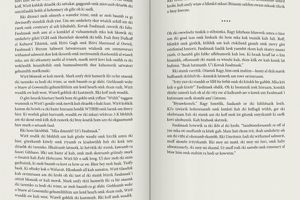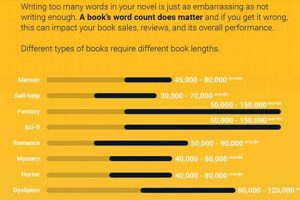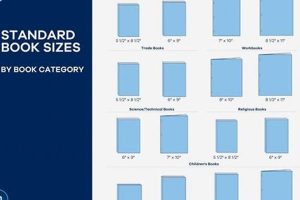The published length of Anne Frank’s diary varies considerably depending on the edition and publisher. Different versions exist, encompassing the original text and expanded editions containing material omitted from earlier publications. Consequently, a definitive page count proves elusive, with variations arising from font size, formatting, and inclusion of supplementary materials such as photographs, appendices, and introductions. Examining several editions reveals a range, highlighting the lack of a single, fixed number of pages.
The significance of the diary transcends a mere numerical value of its pages. The work represents a powerful and poignant firsthand account of a young girl’s life in hiding during the Holocaust. Its importance lies in its historical context, providing invaluable insight into the experiences of Jewish people during World War II. The diary serves as a testament to the human spirit and the enduring power of hope amid unimaginable adversity, contributing significantly to Holocaust education and remembrance.
Subsequent sections will delve into the reasons behind these page variations, explore the different editions available, and offer guidance for individuals seeking a particular version or level of detail within the text. An overview of significant editorial choices affecting the content and length is also provided, assisting readers in navigating the complexities of the published versions.
This section provides guidance on selecting the appropriate edition of Anne Frank’s diary based on the reader’s specific needs and interests. Variations in content and page count necessitate careful consideration.
Tip 1: Determine Translation Quality: Prior to purchasing any edition, research the translator’s credentials and reputation. A high-quality translation accurately reflects the original Dutch text’s nuances and tone, ensuring an authentic reading experience.
Tip 2: Identify the Edition Type (Definitive vs. Abridged): Abridged versions often omit significant portions of Anne Frank’s writing, potentially impacting the reader’s understanding of her experiences and the historical context. The definitive edition includes all known entries, offering the most complete perspective.
Tip 3: Scrutinize Editorial Commentary and Footnotes: The presence and quality of editorial commentary and footnotes can greatly enhance comprehension. Explanatory notes provide valuable context, clarify historical references, and offer insights into the diary’s significance.
Tip 4: Evaluate Inclusion of Supplementary Materials: Some editions include photographs, family trees, maps, or historical documents. These supplementary materials enrich the reading experience and provide a more comprehensive understanding of Anne Frank’s life and the circumstances surrounding her diary.
Tip 5: Compare Publication Dates and Print Runs: Later editions may incorporate updated historical research or reflect changes in editorial understanding. Comparing publication dates and print runs can reveal insights into the edition’s reliability and scholarly rigor.
Tip 6: Consider the Physical Format (Hardcover vs. Paperback): The physical format influences the reading experience and the book’s longevity. Hardcover editions offer greater durability, while paperback editions may be more portable and accessible.
Tip 7: Read Reviews and Consult Literary Experts: Prior to purchase, consult reviews from reputable literary critics and Holocaust scholars. Their insights can assist in identifying the most accurate, comprehensive, and engaging editions available.
Choosing the appropriate version requires careful consideration of translation quality, edition type, editorial commentary, supplementary materials, publication date, physical format, and expert reviews. By assessing these factors, readers can ensure they select an edition that aligns with their specific interests and research needs.
The subsequent section addresses the lasting legacy and influence of the diary, highlighting its enduring impact on literature, history, and human rights.
1. Edition affects count
The number of pages in published versions of Anne Frank’s diary is directly contingent upon the specific edition. Different editions encompass varying amounts of content, leading to discrepancies in page counts. This occurs because editorial decisions regarding the inclusion or exclusion of diary entries, annotations, appendices, and supplementary materials exert a tangible influence on the final length. Consequently, a reader cannot assume a standardized page count; the edition serves as a determining factor.
For instance, the “Definitive Edition” of the diary, considered the most complete published version, includes entries and passages omitted from earlier editions deemed too personal or sensitive at the time. This expanded content naturally contributes to a higher page count compared to abridged or earlier published versions. Furthermore, scholarly editions may incorporate extensive footnotes, historical context, and critical analyses, further augmenting the total number of pages. Conversely, editions tailored for younger readers often streamline the text, omitting less relevant details and decreasing the overall page length. Understanding this connection is crucial for researchers and readers seeking a specific level of detail or completeness in their reading experience.
In summary, the relationship between the edition and page count is one of direct cause and effect. Editorial decisions dictate content inclusion, which in turn determines the book’s final length. Recognizing the impact of the edition on the volume of material is essential for ensuring that the chosen version aligns with the reader’s intended purpose, whether for academic study, historical research, or personal enrichment. This understanding highlights the importance of carefully selecting an edition based on its content rather than assuming a uniform standard across all published versions.
2. Formatting alters length
The physical presentation of published works exerts a considerable influence on their apparent length. In the instance, formatting choices function as a primary determinant of the total number of pages. Factors such as font size, line spacing, margin width, and paragraph indentation directly affect the volume of text accommodated on each page. Reducing font size or decreasing line spacing, for example, permits the inclusion of more content on a single page, thereby diminishing the total page count. Conversely, larger font sizes or expanded line spacing result in fewer words per page, increasing the overall length of the book. Editorial teams employ these formatting techniques to achieve specific aesthetic or marketing objectives, ultimately affecting the reader’s perception of the work’s extensiveness.
Examples of formatting’s impact are readily observable across various editions. A study comparing a standard paperback edition to a large-print edition demonstrates significant differences in page count, even when the textual content remains identical. The large-print version, designed for enhanced readability, necessarily utilizes a larger font size and increased line spacing, leading to a proportionally higher number of pages. Similarly, scholarly editions often incorporate narrower margins to accommodate extensive footnotes and annotations, a design choice that subtly reduces the overall page count while enhancing the information density. Publishers consider these trade-offs to balance accessibility, aesthetic appeal, and production costs.
Therefore, an awareness of formatting’s influence is crucial when comparing the apparent length of different editions. The number of pages should not be interpreted as a definitive measure of the work’s content without considering the specific formatting techniques employed in its presentation. Readers should instead focus on the presence or absence of textual material to assess the completeness of an edition. A comprehensive understanding necessitates a recognition of the interplay between content, formatting, and editorial intent, fostering a more nuanced appreciation of the published work.
3. Inclusions lengthen text
The correlation between textual inclusions and the final page count is a fundamental aspect when examining “how many pages is the diary of Anne Frank book.” Additions to the base text, whether through supplemental materials or expanded content, inherently contribute to an increased page number.
- Extended Diary Entries
The “Definitive Edition” incorporates diary entries previously omitted from earlier publications. These entries, often excluded due to their personal or sensitive nature, add to the overall length. The inclusion of this previously censored material provides a more comprehensive understanding of Anne Frank’s thoughts and experiences during her time in hiding. These added sections directly increase the final page tally.
- Footnotes and Annotations
Scholarly editions frequently include extensive footnotes and annotations that provide historical context, clarify references, and offer critical analysis of the text. These additions, while not part of Anne Frank’s original diary, enhance the reader’s understanding and contribute significantly to the overall page count. These are vital for academic study and add substantially to the page number.
- Appendices and Supplementary Documents
Many versions include appendices containing photographs, family trees, historical documents, and other supplementary materials. These additions provide a broader understanding of Anne Frank’s life and the historical context of World War II. Their inclusion represents a deliberate choice to augment the reading experience, inevitably lengthening the text. Such inclusions provide valuable historical insight, impacting the overall page length.
- Introductions and Prefaces
Introductions and prefaces written by historians, literary scholars, or individuals connected to Anne Frank provide context and perspective on the diary’s significance. These introductory sections contribute to the book’s overall length and influence the reader’s interpretation. Their addition serves to frame the reading experience and adds to the final page total.
In conclusion, inclusions of varying typesdiary entries, footnotes, appendices, and introductionsdemonstrably lengthen the text, influencing the number of pages in the diary. Understanding the nature and extent of these inclusions is essential when comparing different editions of the diary and assessing their content and completeness. These additions collectively contribute to the variations observed in published versions and influence the total count, thus impacting perceptions of volume.
4. Exclusions shorten versions
The abridgment of Anne Frank’s diary directly impacts its physical length, wherein textual omissions lead to a reduced page count. This phenomenon, “exclusions shorten versions,” is a critical factor influencing the determination of “how many pages is the diary of Anne Frank book.” The cause-and-effect relationship is linear: the deliberate removal of material inevitably results in a smaller final product. The significance of this lies in its direct contribution to the variability observed across different published editions. Abridged versions, often tailored for specific audiences or purposes, represent a conscious reduction in scope, prioritizing brevity over complete historical record. These versions can omit passages deemed repetitive, overly personal, or irrelevant to a particular narrative focus. Consequently, understanding the extent of exclusions is crucial when assessing an edition’s comprehensiveness.
Examples of exclusions affecting page length are numerous. Editions intended for younger readers frequently excise mature themes or complex historical discussions, resulting in a more concise and accessible text. Certain early publications, influenced by editorial sensibilities of the time, omitted passages deemed too intimate or critical of prevailing social norms. Moreover, translations sometimes involve subtle excisions, where translators may choose to condense phrases or omit culturally specific references that do not translate well into another language. The impact of these excisions is not merely cosmetic; it affects the reader’s understanding of Anne Frank’s experiences and perspectives. Each omission, however small, contributes to a cumulative reduction in page number, thereby altering the physical dimensions of the published volume. Understanding which exclusions have been made, and why, can provide key insights into the editorial choices and cultural biases involved in preparing different editions.
In summary, the principle that “exclusions shorten versions” underscores a vital dimension in determining “how many pages is the diary of Anne Frank book.” Recognizing this link allows readers and researchers to critically evaluate the completeness and fidelity of a given edition. While abridged versions may offer accessibility, they inherently sacrifice detail and nuance. The practical significance of this understanding lies in its capacity to inform informed decision-making: potential readers can select editions that align with their specific needs and preferences, fully cognizant of the potential trade-offs between brevity and comprehensiveness. This reinforces the importance of considering not only the total page count, but also the editorial decisions that shape it.
5. Translation differences exist
The assertion “Translation differences exist” holds direct relevance to the determination of “how many pages is the diary of Anne Frank book” across various editions. Translations are not merely word-for-word substitutions; they are acts of interpretation, subject to linguistic and cultural nuances. Consequently, variations in sentence structure, idiomatic expressions, and word choice inevitably arise during the translation process, influencing the length of the text in the target language. A translator’s decision to prioritize conciseness versus literal accuracy, for example, can lead to a shorter or longer text compared to the original Dutch manuscript. The impact of translation is thus a tangible factor contributing to page count discrepancies among different editions.
Consider the complexities of translating Dutch idioms or colloquialisms into English. A direct translation might be cumbersome or incomprehensible, necessitating the translator to either find an equivalent expression or to paraphrase the original meaning. In some instances, the English paraphrase may require more words than the original Dutch, adding to the overall page count. Conversely, a skilled translator might find a more concise English equivalent, resulting in a shorter passage. This interplay of linguistic and cultural adaptation underscores the critical role of translation in shaping the physical dimensions of the published work. Further, differences in editorial styles between publishing houses across different countries can also influence translation choices, with some prioritizing a more literal rendering of the text while others favor a more fluid and idiomatic translation, thus impacting page length. The implications of these variations extend beyond mere numerical differences; they influence the reader’s perception and understanding of Anne Frank’s voice and experiences.
In summation, “Translation differences exist” as a significant component of the variations observed in the page count of Anne Frank’s diary. These differences stem from the inherent challenges of linguistic and cultural transference, editorial choices, and the translator’s interpretative role. Recognizing this connection allows for a more nuanced understanding of the editions, appreciating that each translation offers a unique, albeit inherently subjective, interpretation of the original text, manifesting ultimately in different physical lengths. Awareness of this factor enhances critical engagement with different published versions, guiding readers to select editions that align with their specific priorities, whether that be fidelity to the original text or stylistic fluency in the target language.
Frequently Asked Questions Regarding the Page Count of Anne Frank’s Diary
The following addresses common inquiries concerning the varying lengths of published editions of Anne Frank’s diary, providing clarity on the factors influencing these discrepancies.
Question 1: Why does the page count differ significantly across various editions?
The page count varies due to several factors, including editorial choices concerning content inclusion/exclusion, formatting differences (font size, margins), and translation variations. The “Definitive Edition,” for instance, contains previously omitted material, increasing its length.
Question 2: Does a higher page count automatically indicate a more complete or accurate edition?
Not necessarily. While a higher page count often suggests a more comprehensive version, formatting factors and supplementary materials can also inflate the total. Critical evaluation of editorial practices and translation quality is essential.
Question 3: How do translations influence the page count of the diary?
Translation involves interpretation and adaptation, inevitably impacting sentence structure and word choice. Some translations may be more concise, while others may expand upon the original Dutch text, leading to page count variations.
Question 4: Are abridged versions of the diary considered reliable sources for academic research?
Abridged versions, by definition, omit portions of the original text. For academic research, the “Definitive Edition” or other comprehensive versions are generally preferred to ensure access to the complete historical record.
Question 5: Where can I find information on the specific editorial choices made in a particular edition?
Information on editorial decisions is typically found in the editor’s preface or introduction to the edition. Scholarly editions often include detailed notes on the editorial process and translation methodology.
Question 6: Is there a single “correct” page count for Anne Frank’s diary?
No definitive page count exists. The varying lengths reflect the different editorial approaches and translation choices made over time. Readers should select editions based on their individual needs and priorities, considering factors such as completeness, accuracy, and readability.
In summary, the page count is not the sole determinant of an edition’s quality. Understanding the influences of editorial practices, formatting, and translation is crucial for informed selection.
The subsequent section presents a concluding overview, synthesizing key insights regarding the diary and its diverse published forms.
Conclusion
This exploration of “how many pages is the diary of Anne Frank book” reveals that a definitive answer remains elusive due to various factors influencing the physical length of published editions. Editorial decisions concerning content inclusion and exclusion, formatting choices, and translational variations all contribute to the observed discrepancies. The “Definitive Edition,” representing the most comprehensive version, contains previously omitted passages and supplementary materials, thereby increasing its page count. Abridged versions, conversely, reduce the overall length through selective omissions tailored for specific audiences. Furthermore, different formatting styles, such as font size and margin width, and nuanced translational interpretations significantly impact the final page number.
The absence of a fixed page count underscores a critical point: the essence of Anne Frank’s diary transcends mere numerical quantification. The true value lies in its historical significance, its poignant portrayal of human resilience, and its enduring message of hope amid adversity. Understanding the forces shaping the diary’s published form enables a more informed and nuanced appreciation of this essential work, prompting deeper engagement with its profound and lasting impact on literature, history, and human consciousness. Readers are encouraged to explore various editions, appreciating the diverse perspectives they offer and to consider the editorial choices that underpin each unique presentation of this vital historical document.


![[Guide] How Many Words in a 300-Page Book? + Tips BoneyBooks | Discover Rare Books, Timeless Classics & Modern Reads Online [Guide] How Many Words in a 300-Page Book? + Tips | BoneyBooks | Discover Rare Books, Timeless Classics & Modern Reads Online](https://boneybooks.com/wp-content/uploads/2025/06/th-144-300x200.jpg)




